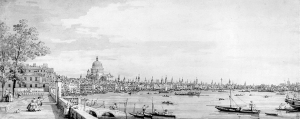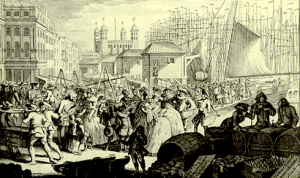The Thames
In the 18th century, the Thames was a major communication route in the capital, for both people and merchandise. London was, at that time, the largest commercial English port, which would not be surpassed by Liverpool until the 19th century. Along the river banks, notably in the City and in the East of London, countless vessels of all sizes would come to load and unload merchandise arriving from far off colonies, as well as from the European continent and the North of England. Navigation was subject to the rhythm of the tides, whose effects were felt as far as the capital, as well as at the mercy of the wind. The banks only rarely had quays, and the docks or warehouses in general opened directly onto the river. Because of their draught, the largest vessels remained moored in the middle of the river, and their content was therefore transferred on barges.

- Canaletto, The Thames
- Canaletto, drawing for A View of the City from Somerset House (drawing, c.1746, Courtauld Institute)
[click on the picture to enlarge it]

- Drawing by Canaletto
- (The Royal Collection c 2000 Her Majesty Queen Elizabeth II)
[click on the picture to enlarge it]

- View of the Legal Quays
- Jean-Louis Boitard, View of the Legal Quays on arrival of a French cargo ship (engraving, 1757)
[click on the picture to enlarge it]
Londoners also used the river a lot to get from one bank to the other; because of the lack of bridges, but also to get from one end of the capital to the other. In particular, the Thames linked Westminister to the City and many passengers preferred the river route to the Strand, which was parallel, because of the latter’s traffic jams. A whole class of ferrymen and bargemen lived off passenger transport, and Rowlandson has left us with the amusing image of their noisy efforts to attract customers. The Thames was also used for the Lord Mayor’s official journeys from the City, or for the Royal Family. So splendidly decorated ceremonial crafts could be seen navigating on the river, like the one William Kent drew in 1732 for Frederick, the Prince of Wales.

